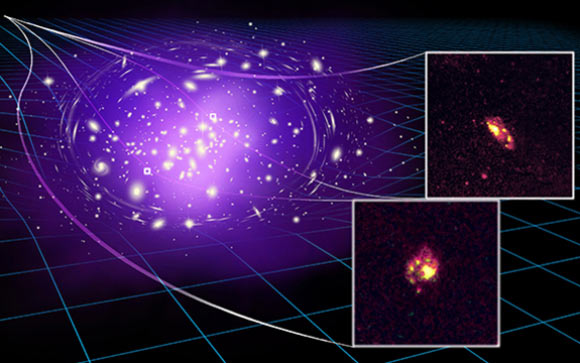Using data from the Near-infrared Integral Field Spectrograph (NIFS) on the Gemini North telescope in Hawai’i, astronomers have identified what they believe is the most ancient spiral galaxy discovered so far.

The spiral galaxy A1689B11 sits behind the massive galaxy cluster Abell 1689 that acts as a lens, producing two magnified images of the spiral galaxy in different positions in the sky. Image credit: James Josephides.
The spiral galaxy in question, A1689B11, existed 11 billion years in the past, just 2.6 billion years after the Big Bang.
Dr. Tiantian Yuan, an astronomer with the Swinburne University of Technology in Australia, and colleagues used a powerful technique that combines gravitational lensing with the cutting-edge NIFS instrument to determine the age and the nature of this galaxy.
“This technique allows us to study ancient galaxies in high resolution with unprecedented detail,” Dr. Yuan said.
“We are able to look 11 billion years back in time and directly witness the formation of the first, primitive spiral arms of a galaxy.”
“Studying ancient spirals like A1689B11 is a key to unlocking the mystery of how and when the Hubble sequence emerges,” said co-author Dr. Renyue Cen, of Princeton University.
“Spiral galaxies are exceptionally rare in the early Universe, and this discovery opens the door to investigating how galaxies transition from highly chaotic, turbulent discs to tranquil, thin discs like those of our own Milky Way Galaxy.”
“Our study shows some surprising features of A1689B11,” Dr. Yuan added.
“This galaxy is forming stars 20 times faster than galaxies today — as fast as other young galaxies of similar masses in the early Universe.”
“However, unlike other galaxies of the same epoch, A1689B11 has a very cool and thin disc, rotating calmly with surprisingly little turbulence.”
“This type of spiral galaxy has never been seen before at this early epoch of the Universe.”
A paper describing the discovery will appear in the Astrophysical Journal and is now available online at arXiv.org.
_____
Tiantian Yuan et al. 2017. The most ancient spiral galaxy: a 2.6-Gyr-old disk with a tranquil velocity field. ApJ, in press; arXiv: 1710.11130







